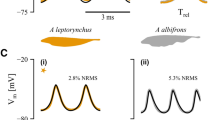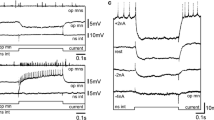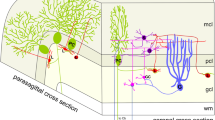Abstract
The medullary pacemaker nucleus of Hypopomus triggers each electric organ discharge (EOD) by a single command pulse. It consists of electrotonically coupled ‘pacemaker’ cells, which generate the rhythm, and ‘relay’ cells, which follow the pacemaker cells and excite the spinal motoneurons of the electric organ. The pacemaker cells receive two inputs from the complex of the diencephalic prepacemaker nucleus (PPn), a GABA-ergic inhibition and a glutamatergic excitation. Relay cells, on the other hand, receive two glutamatergic inputs, one from a subnucleus of the PPn, the PPn-C, and a second from the sublemniscal prepacemaker nucleus (SPPn).
We have labelled afferents to the pacemaker nucleus by injecting HRP to specific sites of the prepacemaker complex. By using immunogold-labelled antibodies and en-grid staining techniques, we demonstrated GABA and glutamate immunoreactivity in labelled synaptic profiles of ultra-thin sections of the pacemaker nucleus. The two types of synapses were interspersed on the surfaces of pacemaker cells, with GABA-immunoreactive synapses apparently representing the GABA-mediated input of the ‘PPn-I’, an inhibitory subdivision of the PPn, and glutamate-immunoreactive synapses representing the input of the ‘PPn-G’, an excitatory subdivision of the PPn. Only glutamate-immunoreactive synapses were found on relay cells.
Similar content being viewed by others
Abbreviations
- AMPA:
-
α-Amino-3-hydroxy-5-methylisoxazole-4-propionic acid
- CP:
-
central posterior nucleus
- EOD:
-
electric organ discharge
- GABA:
-
γ-aminobutyric acid
- GAD:
-
L-glutamate decarboxylase
- HRP:
-
horseradish peroxidase
- JAR:
-
jamming avoidance response
- NMDA:
-
N-methyl-D-aspartate
- PPn:
-
(diencephalic) prepacemaker nucleus
- SPPn:
-
sublemniscal prepacemaker nucleus
References
Bell CC, Finger TE, Russel CJ (1981) Central connections of the posterior lateral line lobe in mormyrid fish. Exp Brain Res 42:9–22
Bendayan M, Zollinger M (1983) Ultrastructural localization of antigenic sites on osmium-fixed tissue applying the protein A- gold technique. J Histochem Cytochem 31:101–109
Bennett MVL (1971) Electric organs. In: Hoar WS, Randall DJ (eds) Fish physiology, vol 5. Academic Press, New York, pp 493–574
Decavel C, van den Pol A (1990) GABA: A dominant neurotransmitter in the hypothalamus. J Comp Neurol 302:1019–1037
Denizot JP, Arnold G, Geffard M, Libouban S (1988) The use of Queto 651 for the post-embedding immunohistochemical demonstration of gamma-aminobutyric acid on semithin sections. Histochem J 20(4): 222–229
De Zeeuw CI, Ruigrok TJH, Holstege JC, Jansen HG, Voogd J (1990) Intracellular labeling of neurons in the medial accessory olive of the cat: II. Ultrastructure of dendritic spines and their GABA-ergic innervation. J Comp Neurol 300:478–494
Dye JC, Meyer JH (1986) Central control of the electric organ discharge in weakly electric fish.In: Bullock TH, Heiligenberg W (eds) Electroreception. Wiley and Sons, New York, pp 71–102
Dye J, Heiligenberg W, Keller CH, Kawasaki M (1989) Different classes of glutamate receptors mediate distinct behaviors in a single brainstem nucleus. Proc Natl Acad Sci USA 86:8993–8997
Elekes K, Szabo T (1981) Comparative synaptology of the pacemaker nucleus in the brain of weakly electric fish (Gymnotidae). In: Szabo T, Czéh G (eds) Sensory physiology of aquatic lower vertebrates. Akadémiai Kiadó, Budapest, pp 107–127
Hagedorn M, Heiligenberg W (1985) Court and spark: Electric signals in the courtship and mating of gymnotoid electric fish. Anim Behav 33:254–265
Hopkins CD (1988) Neuroethology of electric communication. Annu Rev Neurosci 11:497–535
Hopkins CD (1991) Hypopomus pinnicaudatus (Hypopomidae), a new species of gymnotiform fish from French Guiana. Copeia 1991 (1): 151–161
Ji Z, Aas J-E, Laake J, Walberg F, Otterson OP (1991) An electron microscopic, immunogold analysis of glutamate and glutamine in terminals of rat spinocerebellar fibers. J Comp Neurol 307:296–310
Kawasaki M, Heiligenberg W (1989) Distinct mechanisms of modulation in a neuronal oscillator generate different social signals in the electric fish Hypopomus. J Comp Physiol A 165:731–741
Kawasaki M, Heiligenberg W (1990) Different classes of glutamate receptors and GABA mediate distinct modulations of a neuronal oscillator, the medullary pacemaker of a gymnotiform electric fish. J Neurosci 10:3896–3904
Kawasaki M, Maler L, Rose GJ, Heiligenberg W (1988) Anatomical and functional organization of the prepacemaker nucleus in gymnotiform electric fish: The accommodation of two behaviors in one nucleus. J Comp Neurol 276:113–131
Keller CH, Maler L, Heiligenberg W (1990) Structural and functional organization of a diencephalic sensory-motor interface in the gymnotiform fish, Eigenmannia. J Comp Neurol 293:347–376
Keller CH, Kawasaki M, Heiligenberg W (1991) The control of pacemaker modulations for social communication in the weakly electric fish Sternopygus J Comp Physiol A 169:441–50
Kravitz E.A. (1967) Acetylcholine, γ-aminobutyric acid and glutamic acid: physiological and chemical studies related to their roles as neurotransmitter agents. In: Quarton GC, Melnechuk T, Schmitt FO (eds) The neurosciences. Rockefeller Univ Press, New York, pp 433–444
Maler L, Mugnaini E (1986) Immunohistochemical identification of GABA-ergic synapses in the electrosensory lateral line lobe of a weakly electric fish (Apteronotus leptorhynchus). Soc Neurosci Abstr 12:312
Metzner W (1993) The jamming avoidance response in Eigenmannia is controlled by two separate motor pathways. J Neurosci 13(5): 1862–1878
Somogyi P, Soltész I (1986) Immunogold demonstration of GABA in synaptic terminals of intracellularly recorded, horseradish peroxidase-filled basket cells and clutch cells in the cat's visual cortex. Neuroscience 19 (4): 1051–1065
Van den Pol A, Decavel C (1990) Synaptic interactions between chemically defined neurons: dual ultrastructural immunocytochemical approaches. In: Hjörklund A, Hökfelt T, Wouterlook FG, van den Pol AN (eds) Handbook of chemical neuroanatomy. vol 8. Elsevier Science Publishers, Amsterdam, New York, vol 8, pp 199–271
Vu ET, Krasne FB (1992) Evidence for a computational distinction between proximal and distal neuronal inhibition. Science 255:1710–1712
Wong CJH, Heiligenberg W (1993) Diencephalic inhibitory projections to the pacemaker nucleus of the weakly electric fish, Hypopomus. Soc Neurosci Abstr 156, 17:377
Author information
Authors and Affiliations
Rights and permissions
About this article
Cite this article
Kennedy, G., Heiligenberg, W. Ultrastructural evidence of GABA-ergic inhibition and glutamatergic excitation in the pacemaker nucleus of the gymnotiform electric fish, Hypopomus . J Comp Physiol A 174, 267–280 (1994). https://doi.org/10.1007/BF00240210
Accepted:
Issue Date:
DOI: https://doi.org/10.1007/BF00240210




